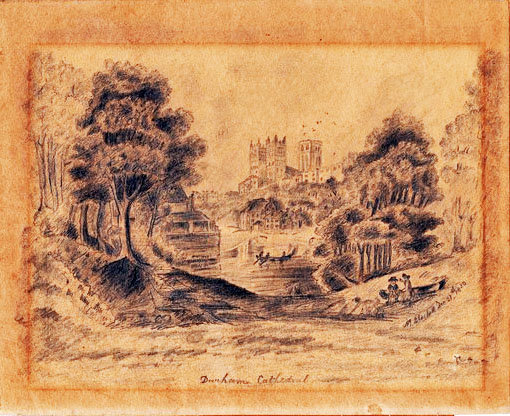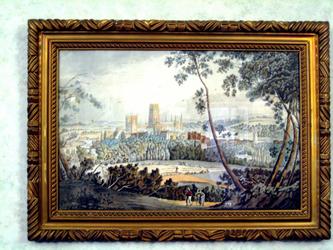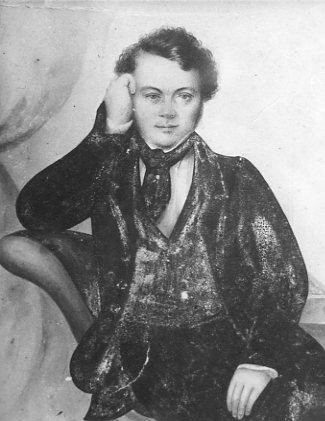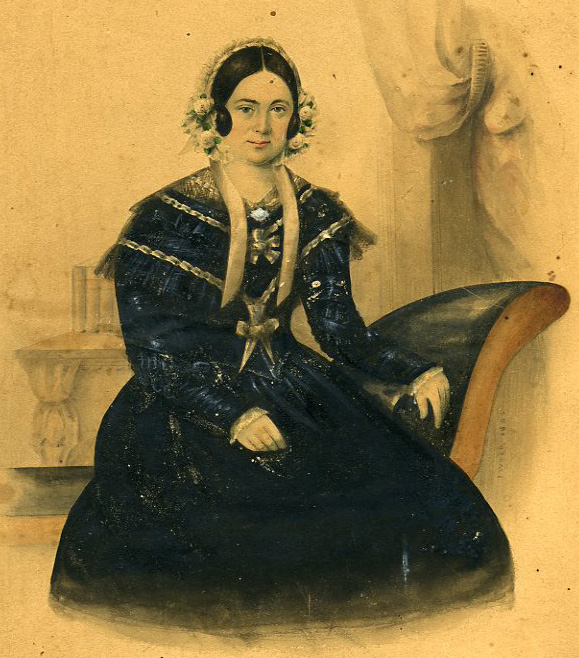This important line has now (August 2013) been linked to the Main Blackett Tree and it is reasonably certain that Joseph Blackett was a son of Cuthbert Blackett (1703-1778) and Alice Parmeley of Hamsterley. This would normally result in this page being removed, but in view of length of time it has taken to establish the link and the number of lines of descent involved, including Blacketts in East Anglia, Australia and New Zealand, we have decided to leave it in place and include an outline of how we have reached our conclusions. Additionally, we have not yet found a baptism – presumably a nonconformist one – for Joseph Blackett, nor have we yet found the links, if any, between him and the other branches mentioned towards the end of this page.
Joseph Blackett, who married Elizabeth Watson on 27 July 1771 in St. Oswald, Durham City, is described in parish records as a wheelmaker or spinnelwheel-maker.(See Note 1) In the 1771 marriage entry Joseph is shown as a widower and Elizabeth as a widow. Elizabeth’s maiden name was Morgan. She married her first husband, Richard Watson, an innkeeper, in St. Oswald, Durham City in 1769 but he died the following year. Elizabeth was buried in St. Oswald, Durham City in 1782 and Joseph then married Elizabeth Penny in 1794. She died in 1827 in Framwellgate. Joseph’s first wife was probably yet another Elizabeth, “wife of Joseph Blacket (papist)”, who was buried in Durham St. Oswald in 1770, though it is not clear whether the term “papist” was accurate, or simply signified a nonconformist.
In his book, My Name Is Blacket, Nick Vine Hall, partly relying on earlier research carried out by the late Cedric Blackett, showed Joseph to be the son of Henry Blackett (1705-1744) of Witton-le-Wear. This seemed to us to be unlikely. In an 1811 submission to the College of Arms the eminent historian and genealogist Robert Surtees shows this Henry as having had five daughters but no sons. This is confirmed by Henry’s Will dated 3 Oct 1744. Moreover, Surtees also refers to a Grant of Administration de Bonis Non taken out in 1787 by Katharine (b.1729), Henry’s eldest daughter, and her husband, Nicholas Clarke, covering the unadministered part of the estate of Henry’s grandfather, also Henry (1639-1704), there being no surviving male issue. Surtees goes on to state that “it seems pretty plain that all the male line of Henry… is extinguished.”
Henry’s family were Anabaptists, based around Witton-le-Wear. Despite lengthy research, we found no mention in Anabaptist records of a Joseph Blackett being excommunicated from their church and no record of Joseph’s baptism or birth in either Anabaptist records or the parish registers covering Durham City held at Durham Record Office, nor in the Witton or Hamsterley registers, despite Joseph’s burial entry stating that he was a native of Hamsterley. Both Cedric Blackett and the Hudleston papers held by Durham University show Joseph Blackett as having been born in 1733, but this may have been based on his being shown as aged 70 in the entry for his burial in the 1803 St. Oswald register. It is not clear whether or not both authorities came to their conclusions independently or whether one followed the other.
Assuming that the burial reference to Joseph being a native of Hamsterley born around 1733 was correct, this narrowed down the potential families considerably and the name of “Cuthbert”, which Joseph gave to two sons in succession (the elder died an infant) seemed significant. Despite St. Cuthbert being the Patron Saint of Durham, and therefore the name cropping up relatively frequently in the 18th and 19th centuries, only 31 Cuthbert Blacket(t)s, with or without a middle name, have been found.
Discounting Rev. Cuthbert Blacket, born in New South Wales, Australia in 1862 (who himself descended from a Hamsterley family), all but three of the remaining Cuthberts descended either from Joseph of Durham City or from Cuthbert Blackett (1703-1778) and Alice Parmeley of Hamsterley. Although Cuthbert and Alice married in 1726, we have found no earlier baptisms of their children before Rachell on 14 March 1737/8, followed by two more children, suggesting that there were more elder children, perhaps given nonconformist baptisms, during the first 12 years of Cuthbert and Alice’s marriage. That could of course include Joseph, and the hypothesis that all Cuthbert Blacketts stemmed from this line was supported by the fact that Joseph and Elizabeth’s 2nd and 3rd sons (baptised 1775 and 1777) were named Cuthbert, and their daughter (baptised 1778) was named Alice. The Cuthbert Blackett born in 1703 was the illegitimate son of Elizabeth Blackett and Cuthbert Johnson, from whom the name “Cuthbert” presumably originally came.
There remained, however, those three exceptions. The first was Cuthbert Blackett, a journeyman mason aged about 30, living in 1841 in New Painshaw (sic) with his wife and three children plus a Sarah Blackett aged 68. The second and third Cuthberts were his grandsons, born 1878 and 1883. If Cuthbert the grandfather was from a different line, that would rule out the theory that there was only one line of Blacketts using the name of Cuthbert.
It now seems, however, that this Cuthbert Blackett was born Cuthbert Barker, the son of Anthony Barker and Sarah Blackett (1773-1846), the granddaughter of Cuthbert Blackett and Alice Parmeley, and that he and his mother had adopted her maiden name by 1841. This conclusion has been arrived at by an exhaustive process of elimination, examining all parish records and censuses for both Cuthbert and Sarah Blackett/Barker/Baker, and there seems little doubt that Cuthbert Blackett and Cuthbert Barker are one and the same person. That leaves just the two lines of Cuthbert Blacketts: the one descending from the illegitimate Cuthbert born 1703 in Hamsterley, and the Cuthberts descending from Joseph, born around 1733, also in Hamsterley. Given the other circumstantial evidence mentioned above there seems little doubt that these Cuthberts descend from the same line and that Joseph was the son of Cuthbert.
A few more facts about the family of Joseph may be of interest. Joseph had at least two surviving sons. By 1799, the elder son, Henry Brymer Blackett, had settled in Darlington, about 18 miles south of Durham City, where he was working as a machine maker at the time of his marriage. He remained in Darlington and continued his trade at least until 1851. His eldest son, Henry, took up a similar occupation but had moved to Barnard Castle by the early 1820s.
The younger son, Cuthbert, followed in his father’s footsteps as a spinnel wheel1 maker and also moved to Darlington, where, like his brother, he married in 1799. By 1801, however, he had returned to Durham City, continuing his trade, and was living at Abbey Mill, Durham (see Note 2) from at least 1804 to 1820. Pigot’s directories of 1828/29 and 1834, however, show Cuthbert carrying on business (in partnership with Thomas Gainforth, who was probably his step-brother) as Blackett & Gainforth, carpet and worsted manufacturers of Framwellgate, and Cuthbert and Thomas, trading under the name of Blackett and Gainforth of Framwellgate, are reported in the London Gazette as having executed an indenture for the benefit of their creditors on 12 November 1839. It is possible that the worsted business had commenced at Abbey Mill as William Dean is shown as a worsted manufacturer of Abbey Mill in 1828/29 and, with Matthew Dean, in 1834, (they are shown as worsted manufacturers, living in South Street, Durham City in 1841). The premises may therefore have been used by Cuthbert Blackett for manufacturing worsted before Blackett & Gainforth moved into newly built premises on the east side of Framwellgate some time after 1823, and continued as a worsted mill after Cuthbert had moved. Interestingly, the previous occupant of the Framwellgate premises was Thomas Watson, the same surname as Cuthbert’s mother at the time of her marriage to Joseph Blackett in 1771. Cuthbert is shown in 1841 as a “worsted manufacturer” living in Framwellgate, Durham City, and in 1851 as a “retired worsted and carpet manufacturer.”

Cuthbert’s daughter Mary Blackett (1809-1891) drew the sketch of Durham Cathedral shown on the left, reproduced with thanks to Paul Dobson. Abbey Mill is clearly visible on the bank of the river. Some years later, Mary painted the view of the Cathedral shown below the sketch. She gave the painting to her brother Henry when he emigrated to New Zealand (see next paragraph) to remind him of home, and the painting is now owned by the family of Phil Tomlinson, a descendant of Henry Blackett. A number of sketches by Mary plus other images can be viewed at Phil’s excellent site, Tomlinson & McCallum Family.

From 1852 onwards several of Cuthbert’s children emigrated to Australia and New Zealand (see Henry Blackett in Blacketts down under), where their descendants still live. These included Cuthbert Robert Blackett and his wife Margaret (nee Mordey), and Ann Blackett and her husband Luke Forster. (See Note 3) Additional important Blackett lines descend from Joseph Blackett and Elizabeth Watson, including some of the East Anglian Blacketts, and the line that includes Col. William Cuthbert Blackett C.B.E. (see A Blackett aid to miners).

 The images on the left are believed to be of Luke and Ann Forster, painted in 1846, before they emigrated, and though they bear the annotation “J. Wood” (presumably the artist) and the 1846 date, no names of the sitters are shown. It is possible that copies were made and distributed amongst this branch of the family and if you recognise or have any information on the portraits that may help to identify the sitters please contact us. Sue Beatty, with whose permission the images are shown, hosts a very interesting and informative website on the Forster/Blackett family history.
The images on the left are believed to be of Luke and Ann Forster, painted in 1846, before they emigrated, and though they bear the annotation “J. Wood” (presumably the artist) and the 1846 date, no names of the sitters are shown. It is possible that copies were made and distributed amongst this branch of the family and if you recognise or have any information on the portraits that may help to identify the sitters please contact us. Sue Beatty, with whose permission the images are shown, hosts a very interesting and informative website on the Forster/Blackett family history.
No connection has been discovered between Joseph’s family and that of John Blackett, a joiner, who by his wife, Jane had at least six children baptised at St. Mary in the South Bailey (St. Mary the Less), Durham City between 1681 and 1703. For a descendancy chart of John Blackett and Jane please click here.
An interesting connection has emerged between Joseph Blackett of Durham City and Joseph Blackett who married Ann Lister in 1793 in Welbury, Yorkshire. The latter Joseph was admitted to the Restoration [masonic] Lodge, Darlington in 1802, described as a farmer of Welbury, aged 33. Ten years later, around 1812, Henry Brymer Blackett, the elder son of Joseph Blackett and Elizabeth Watson, joined the same lodge, of which he was later Master on several occasions. (See Note 4) This coincidence raises the possibility that Joseph was related in some way to Henry Brymer Blackett. However, Joseph did not propose Henry Brymer Blackett for membership of the lodge and Joseph is mentioned in the lodge minutes of 1803 as having joined aged 30, an innkeeper, but “he is not a member of this lodge”. It appears, therefore, that Joseph and Henry Brymer Blackett were not members at the same time and the Masonic connection may be no more than a coincidence. Joseph was a son of Joseph Blackett of Yarm, Yorkshire, and Barbara Smith and Joseph senior is now believed to descend from the Blacketts of Urra, Yorkshire, as shown in Blacketts of Yorkshire and Michigan, USA. That tree now forms part of the Main Blackett Tree due to the marriage of a later descendant.
Notes:
1. “Spinnel” is an archaic form of the word “spindle”. It was already falling out of use at the beginning of the 19th century and in Cuthbert’s marriage entry and the baptismal entries for three of his children the word “spinning” is used instead.
2. Abbey Mill is now known as The Old Fulling Mill, and is on the south-west of the peninsula beneath the cathedral. It is now a museum and part of Durham University. Formerly known as Jesus Mill, it was leased in 1792 “for the carding of wool and cleaning of cloth”. (Fulling mills were used for the beating and cleaning in water of cloth in order to make the fabric denser.) The 1794 St. Oswald burial record of John Southers/Sutherst describes him as “master of the jenny spinners at Abbey Mill”. Another Abbey Mill at one time stood on the opposite bank, but was destroyed by floods in 1771.
3. Despite the coincidence of Blackett/Forster names and the Australian connection, the connection, if any, between the family of Luke Forster and that of George Forster Blackett mentioned in Northumberland Blacketts below, after whom the town of Blackett, New South Wales is named, has not been established.
4. We are indebted to Tom Blackett for this information.
